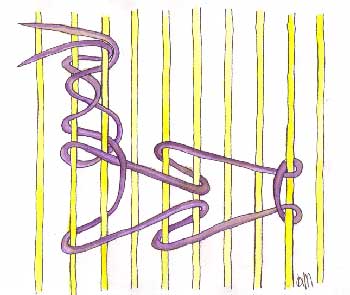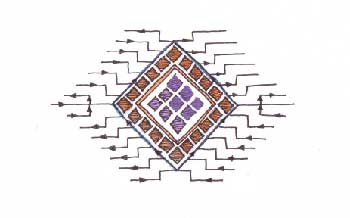 Getting up close with the textiles from Bhutan is extraordinary. I can hardly see the weave with a gigantic magnifier so I’m sure I wouldn’t be able to actually weave it! The weavers are often in dimly lit rooms too.
Getting up close with the textiles from Bhutan is extraordinary. I can hardly see the weave with a gigantic magnifier so I’m sure I wouldn’t be able to actually weave it! The weavers are often in dimly lit rooms too.
This type of weave is used in making the Kira – the womens’ national dress. The longer horizontal arms are made with a type of soumak stitch manipulated by hand through an open shed. The weavers use a beautiful pointed pick up stick to assist them. This type of stitch allows a long horizonal line without floats. You can see the other diamond shaped patterns are woven by a straight pick up and have small floats.
 Here is a diagram of how I think the horizontal work is done using one thread doubled by anchoring it around a warp thread. To go up the vertical the threads are basically twisted around each other and anchored under a warp ready to do the soumak line again. This works because the warp is fine, sett at 115 epi. The diagram only shows the soumak work but rows of plain weave are woven as well.
Here is a diagram of how I think the horizontal work is done using one thread doubled by anchoring it around a warp thread. To go up the vertical the threads are basically twisted around each other and anchored under a warp ready to do the soumak line again. This works because the warp is fine, sett at 115 epi. The diagram only shows the soumak work but rows of plain weave are woven as well.
I also tried this on a much coarser sett and it was a great way to introduce texture and line patterning to a plain weave. The soumak creates a raised texture which sits higher than the surrounding ground weave. As the pattern is worked on the open shed it only shows on the face of the textile.
 There’s a poetry about the weave. Over 5 and back 2, working on the diagonal for the pick up pattern and working many different coloured threads. This rhythm is evident not only in the design but the way it is worked. I was a bit surprised by this, but then I shouldn’t have been. This type of skill is taught. It isn’t a free flowing, unorderly work of self expression. It is a highly technical skill which takes 6 years of study to learn (if you attend the college in Thimpu) and order in working is important.
There’s a poetry about the weave. Over 5 and back 2, working on the diagonal for the pick up pattern and working many different coloured threads. This rhythm is evident not only in the design but the way it is worked. I was a bit surprised by this, but then I shouldn’t have been. This type of skill is taught. It isn’t a free flowing, unorderly work of self expression. It is a highly technical skill which takes 6 years of study to learn (if you attend the college in Thimpu) and order in working is important.
If you look at the illustration of the pattern, you can see the the arrows showing the direction of the soumak weave. It has a mathematical and sublime quality.
I know our textiles tell stories but in getting very close to this special Bhutanese weave I really discovered more about the people and country of Bhutan. These expressions are woven with the style, patterning, colour and structure of the cloth itself. Woven textiles are created to inspire the heart and the Bhutanese have a special word for it – Hingtham which means ‘heart weaving’. A language that has a word for this indicates the value of textiles in the culture. As a weaving community we need to make new special words to succinctly express our passion for our art and its connection to our lives.
I have a short video on YouTube where you can see a weaver in Bhutan doing the weave with the pick up stick.

Leave a Reply